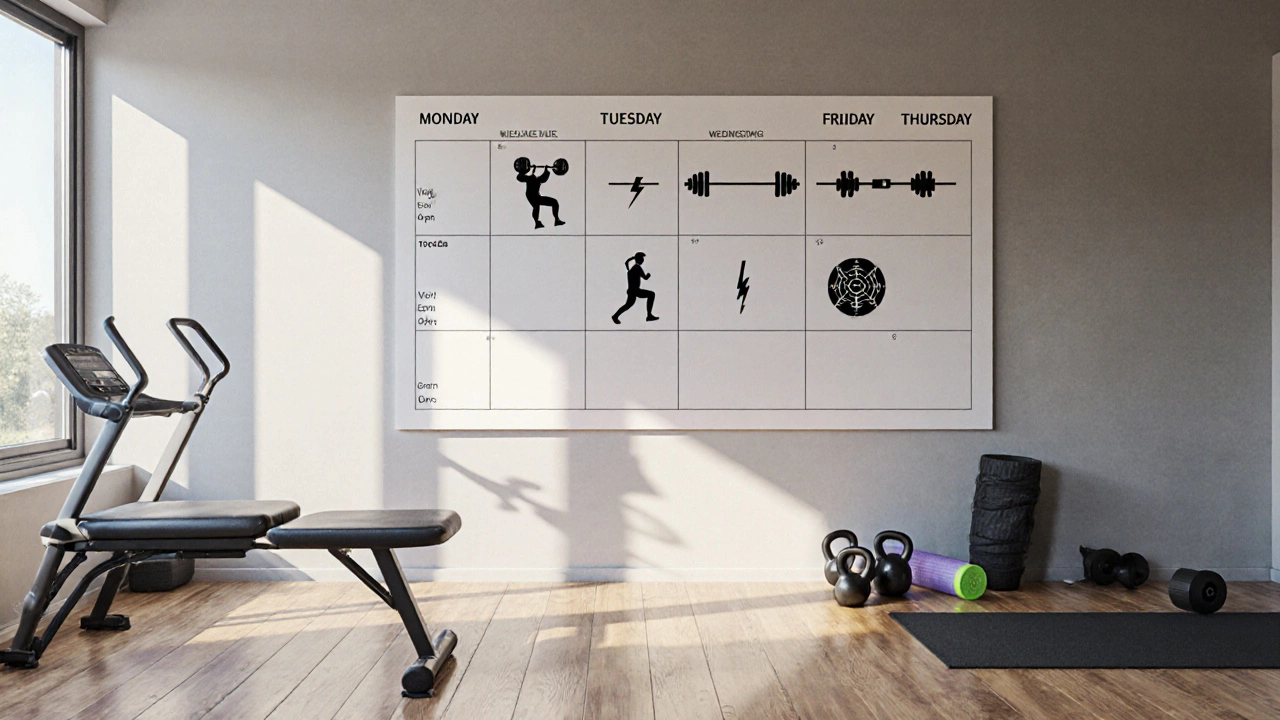Daily Workout Risk Calculator
How Safe Is Your Routine?
Enter your workout details to get a personalized risk assessment based on fitness science principles.
Your Risk Assessment
Critical Checks
Ever wondered if hitting the Gym is something you can do 7 days a week without blowing up? You’re not alone. Many people think “more is better” and end up overcooking their routine. This article breaks down when a daily gym habit works, where it can backfire, and how to keep the gains flowing while staying safe.
What Does a 7‑Day Gym Routine Look Like?
First, let’s paint a realistic picture. A daily schedule rarely means crushing heavy lifts at the same intensity every single session. Successful 7‑day plans usually mix Exercise types-strength, cardio, mobility, and active recovery-so each muscle group gets a break while you stay moving.
- Monday: Upper‑body strength (push‑focused)
- Tuesday: Lower‑body strength (squat‑focused)
- Wednesday: Light cardio + mobility
- Thursday: Upper‑body strength (pull‑focused)
- Friday: Full‑body circuit (moderate load)
- Saturday: HIIT or sport‑specific drill
- Sunday: Active recovery - foam rolling, yoga, easy walk
Notice the ebb‑and‑flow pattern? It lets you train every day while still giving each tissue a chance to repair.
Potential Benefits of Training Every Day
When you plan it right, a daily gym habit can deliver real upside.
- Cardiovascular Health: Consistent moderate‑intensity work improves heart efficiency and lowers resting blood pressure.
- Skill Mastery: Repetition helps you perfect technique faster, whether it’s deadlifting or kettlebell swings.
- Metabolic Boost: Moving daily keeps your metabolism elevated, aiding weight‑management goals.
- Habit Formation: A 7‑day cadence cements gym‑going into a non‑negotiable habit, making it easier to stay consistent long‑term.
These perks are most noticeable when you pair training with proper Nutrition and sleep.

Common Risks and Warning Signs
Training seven days a week isn’t a free pass to ignore recovery. The biggest enemy is Overtraining. Here’s how it shows up:
- Persistent muscle soreness that lasts more than 72hours
- Sleep disturbances or feeling unusually fatigued
- Plateaued or declining performance despite “hard work”
- Frequent colds, mood swings, or irritability
If you notice two or more of these, it’s a red flag. Ignoring them can lead to chronic injuries, hormonal imbalance, and burnout.
How to Build a Safe Daily Workout Plan
Below is a step‑by‑step guide to structuring a 7‑day routine that minimizes risk.
- Identify your primary goal (strength, endurance, weight loss).
- Choose a split that alternates high‑intensity and low‑intensity days.
- Assign each muscle group a maximum of two high‑load sessions per week.
- Incorporate at least one “active recovery” day with Mobility work or light cardio.
- Track volume (sets × reps × weight) and keep a weekly cap (e.g., 20-25 total sets per major muscle group).
- Schedule sleep - aim for 7‑9hours each night and note any night‑time wake‑ups.
- Adjust on the fly: if a session feels “hard” for no reason, swap it for a recovery activity.
Remember that “hard” isn’t always “good”. Quality beats quantity every time.
Recovery Tools That Keep You Going
Recovery isn’t an afterthought; it’s a core part of the plan.
- Sleep: Deep‑sleep cycles trigger growth hormone release, crucial for muscle repair.
- Muscle Recovery strategies: foam rolling, compression garments, and contrast showers speed up blood flow.
- Hydration: Aim for at least 2.5L of water daily; electrolytes matter on sweaty cardio days.
- Protein intake: 1.6‑2.2g per kilogram of bodyweight spreads across meals to fuel rebuilding.
When these pillars are solid, your body can handle the extra training frequency.

When to Take a Break - Listening to Your Body
Even the best‑planned routine needs a reset sometimes. Here’s a quick decision tree:
- If you have 2+ overtraining signs → schedule a full rest day or two.
- If you’re feeling mentally drained → switch a heavy lift day to a light‑cardio or mobility session.
- If you missed a night of sleep → keep the day’s workout under 30minutes and focus on movement, not load.
Skipping an occasional rest day won’t erase your progress; it often accelerates it.
Bottom Line - Is It Worth It?
Answering the original question: a 7‑day‑a‑week gym habit can be good **if** you respect recovery, vary intensity, and monitor your body’s signals. For beginners, starting with 3‑4 days and gradually adding low‑impact sessions is safer. For seasoned lifters who already have sleep, nutrition, and mobility on point, a well‑designed daily plan can boost consistency and skill mastery.
| Aspect | 5‑6 Days | 7 Days |
|---|---|---|
| Recovery Time | 1‑2 full rest days; ample muscle repair | Active recovery only; higher risk of lingering soreness |
| Consistency | May miss occasional weeks | Builds a stronger habit loop |
| Injury Risk | Lower, especially for beginners | Higher if intensity isn’t managed |
| Performance Gains | Steady, sustainable progress | Potentially faster skill acquisition |
| Mental Fatigue | Less likely to burn out | Requires strong motivation and monitoring |
Frequently Asked Questions
Can I go to the gym every day without getting injured?
Only if you balance high‑intensity work with active recovery, keep volume in check, and listen for early signs of overtraining. Skipping proper warm‑up or loading the same muscle group daily dramatically raises injury risk.
How many rest days do I really need?
Most research suggests 1‑2 full rest days per week for the average adult. Athletes who train daily replace those rest days with low‑impact mobility or light cardio sessions, which still count as “active recovery.”
What’s the best way to structure a daily gym session?
Start with a 5‑minute dynamic warm‑up, follow with the main focus (strength, HIIT, or cardio), keep the core work under 45minutes on high‑intensity days, then finish with 5‑10 minutes of mobility or stretching.
What are signs I’m overtraining?
Persistent soreness, trouble sleeping, decreased performance, frequent illnesses, irritability, and a lingering feeling of fatigue are common indicators. When two appear together, take a rest day immediately.
Does daily training improve muscle growth?
Muscle growth hinges on stimulus plus recovery. Training the same muscle hard every day hampers growth; however, a split that hits each muscle 2‑3 times per week with lighter sessions on other days can still produce hypertrophy, provided nutrition and sleep are on point.
